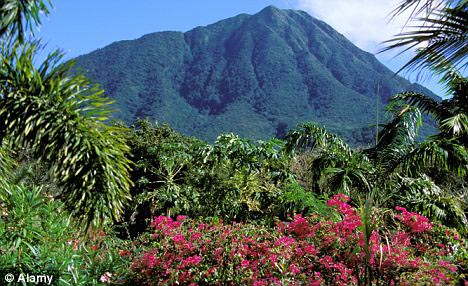 |
 |
Published |
Nevis: The Caribbean Island gem set to steal Antigua's crown

Nevis is to Antigua what Versailles is to the Bronx. The airport is small, modern and efficient. There's only a small runway for light planes, so you don't have the giant-jet chaos that blights so many unmodernised Caribbean airports. And in Nevis you meet the nice Caribbean folk.
The customs man spent a few minutes helping us lug our cases (really) and offering good advice on where to go on the island. You may have guessed that I have recently ceased being a fan of Antigua as a tourist resort but, trust me, Nevis - a mere plane hop away - really is something else.
The first thing I discovered was the number of lovely British expats who have opted to start a new life in their mid-life on the island. Thelma Claxton (TC, as everyone calls her) from Leeds, a Metrobus double-decker driver for 15 years, forsook, with pleasure, the gritty Northern industrial city in 1993 to morph into a Caribbean tour guide and taxi driver on Nevis.
Flame-haired Thelma has married a local and driven Meryl Streep and Mel from the Spice Girls - and she and her cab are yours for a mere $25 (about £15) a day, unless you are a smoker or accompanied by a dog, in which case you are not welcome.
I've always loved it here,' says TC. 'This is paradise. All I ever ask myself now is why it took me so long to make the change.'
I was advised to have lunch at Bananas, well up in the foothills on the volcanic slope of the island. This very tropical restaurant is very, very Caribbean and run by another expat, Gillian Smith, who came to Nevis ten years ago from Doncaster and won't be returning in a hurry.
She bought Bananas when it was a broken-down shack set in a couple of wild jungly acres. The property cost her the equivalent of £4,000 and is worth £600,000 today. She serves a stunning lunch and dinner with a headline dish of tannia fritters - a root vegetable grated with egg, cooked in batter and served with a hot sauce. Fantastic. Couldn't eat enough.
Yet another young British expat, Elizabeth Smith from North-West London, has joined the Nevisian rush. Elizabeth runs a modest cafe on what will soon be prime seafront property just on the edge of the Nevis capital of Charlestown. She prepares meals from a large trailer on the site and has also bought about six acres of converted sugar mill up-country as her new home.

Country club chic: The Montpelier Plantation Inn oozes old English charm
When you first enter Charlestown you wander into a largely 18th Century townscape (much of it restored) looking much as it must have done in its colonial days.
There is a complete absence of ugly, jerry-built high-rises, which are forbidden anywhere in Nevis. Instead there is a small, graceful collection of very old buildings. Yet Charlestown is not a tourist confection - it is a living, working community with a cotton ginnery - where they used to bale cotton --and clusters of Georgian two-storey stone and wooden buildings that give the town immense style and real character.
Nevis covers only 36 square miles and you can drive right round it in 40 minutes. The island is as close to the popular, traditional concept of the Caribbean island as any location I have visited in the West Indies. You will not, I promise, be disappointed here. The people are warm and friendly and generally display none of the creeping Caribbean 'attitude' towards tourists.
I visited three hotels on the island. First was the Montpelier Plantation Inn, a much vaunted Relais & Chateaux property. It is not on the beach but has a pleasantly cool location inland. If you do fancy a dip in the sea though, it does have its own private beach a mile or so away, with shuttle access.
The Montpelier is rather like an English country club with members who return each year. It is a warm, intimate, very English-style hotel with beautiful tropical gardens and only 17 guest rooms, each luxuriously fitted out and with private verandas.
In the evening, you dress sensibly for drinks at the bar, and the regulars will go out of their way to make you feel welcome - just don't bring any children and don't expect a disco.
By the way, when it was a sugar plantation, this place was the venue for the wedding of Admiral Nelson and his Nevisian love, Fanny Nisbet.

Undiscovered paradise: Nevis is just a short hop away form the other Caribbean islands but is world's away in character
One reason this place is such a draw with Britons is that the owner/ manager, Tim Hoffman, lives on site with his family and has a hand-picked and very loyal permanent staff. Tim is a tall American from the Bahamas whose policy is to reinvest the inn's profits in restoration work and constant upgrading. 'I like the inn's Anglo-centricity,' he explained to me, 'and our Brits in turn go for charm, food and character.'
Next, I went down to the sea and stayed briefly at the Oualie Beach Resort. This is essentially a roomy backpackers' hotel and a home for watersports enthusiasts. The accommodation is basically OK, but a rogue cow deposited quantities of dung on the not very clean beach and I found some of the staff somewhat cavalier. There was, when I was there, no cereal or fresh fruit for breakfast.
Finally, I spent a day at the nearby Nisbet Plantation Beach Club, the Caribbean's only deluxe plantation hotel located directly on the beach. It has earned a clutch of awards and when you arrive you'll discover why. Service is intensely personal and the manager, ebullient American Jamie Holmes, makes you feel like a genuine friend. The rooms are individual bungalow-type, all within earshot of the surf and with very posh furnishings. The beach is broad and long and you can lie on comfortable sunloungers all day without seeing or hearing another guest. There's also a smashing pool.
The hotel is larger than the Montpelier Plantation, more family-orientated (kids will love it) and has more services, with a broader target clientele than the Montpelier. If I spend another week, as I plan to, on this pretty island I'll divide my time between these two first-class hotels.
Incidentally, a private water taxi can bring you directly to the Nisbet from St Kitts, the next-door island which has an international airport, in ten minutes.
To get a flavour of Nevis's past, I visited several of its dilapidated sugar mills and hired Jim Johnson, a local hiking guide who charges $20 an hour (about £12) for a fascinating and reasonably unstrenuous walk through secondary forest growth on the foothills of Mount Nevis, which towers over the island.
There is an unusual green footnote I should add. Nevis is about to become one of the few places in the world to be wholly self-supporting in its energy needs, thanks to geothermal power.
Kerry McDonald, the boss of the company producing this minor miracle, explained to me how he has drilled two miles down into volcanic rock containing super-heated water.
Once the rock is fractured, the water is released as steam which drives turbines. By the end of 2010, Nevis hopes to be completely free of fossilfuel energy dependence, apart from the fuel needed for motor vehicles.
Nevis has class. It is at the calm end of the spectrum of wildly differing Caribbean island chains. It fulfils that elusive dream - the Caribbean island of our imagination. And there are not many of those places left.
Travel Facts
American Airlines (020 7365 0777, www.aa.com) flies to St Kitts via New York or Miami from £629 return.
More details on the Montpelier Plantation Inn at www.montpeliernevis.com. Nisbet Plantation Beach Club: www.NisbetPlantation.com. Oualie Beach Resort: www.oualiebeach.com.
Tour operators featuring Nevis include ITC Classics, www.itcclassics.co.uk
More articles
- September 17 - Nicaragua's miles better
- December 16 - The island rising from the ashes
- December 15 - High life in Hong Kong
- October 2014 - Souk some up in Agadir
- July 2014 - From Bangkok to Singapore
- Oct 2013 - A Mayan Cruise
- May 2013 - Florida Keys
- Mar 2013 - Ile de re France
- Jan 2013 - Bahamas
- Sept 2011 - Harrachov, Czech Republic
- Nov 2009 - Bermuda
- Aug 2009 - Nevis
- May 2008 - Zanzibar
- Feb 2008 - Galapagos
- July 2005 - Montserrat
- Apr 2005 - Maine and South Carolina
- March 2005 - Panama
- Sept 2003 - Belize
- Jan 2002 - Tijuana - Mexico